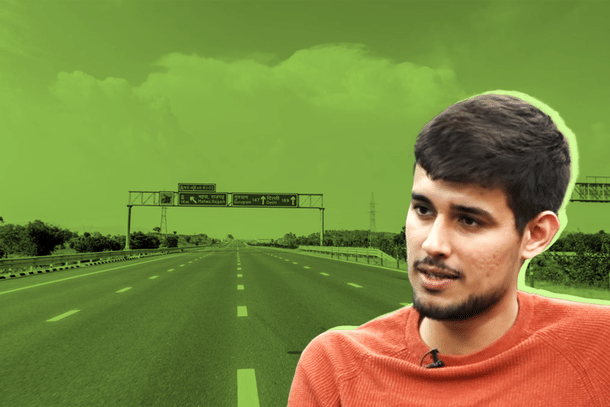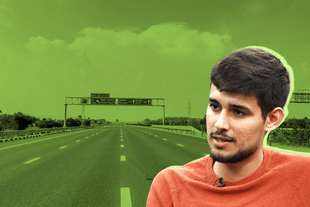Infrastructure
Dear Dhruv Rathee, It's Time You Pump The Brakes On Your Hot Takes Against Highways
Swarajya Staff
Jun 28, 2024, 06:38 PM | Updated 06:43 PM IST
Save & read from anywhere!
Bookmark stories for easy access on any device or the Swarajya app.


If Dhruv Rathee's election rants wore you out, brace yourself — he's not ready to pump the brakes on his hot takes just yet.
In his recent video, 'What if I Become India's Prime Minister?' the controversial YouTuber has set social media abuzz by advocating for reallocating government funds from building highways to education. The viral video, citing instances of low ownership of cars in the country, also goes on to suggest that India needs to shun the construction of big highways and car-centric infrastructure in its cities.
History is rife with instances where public opinion initially opposed highway construction, only to later acknowledge its transformative impact. The 48,000 miles of interstate highway that would be paved across the US during the 1950s, '60s, and '70s faced significant protests, yet ultimately reshaped the American economy.
1. Arteries of progress
"I'm strongly against constructing big highways and car-based infrastructure in our cities," Rathee said in his video. However, this is not the first time Rathee has argued against the creation of infrastructure, and this stance overlooks crucial considerations.
Highways allow better transportation between cities and provide more people with access to opportunities. Despite constituting just 2.3 per cent of India's road network, they handle a substantial 40 per cent of road traffic.
Even if only 8 per cent of families own cars, as claimed in the video, highways are still heavily used by motorcycle owners and the general public via public transportation.
Furthermore, the expansive highway network facilitates the seamless movement of goods through container transfers from ships to trains to trucks, boosting logistical efficiency.
Consider this — around 75 per cent of toll revenue comes from trucks and commercial vehicles, with cars contributing the remaining 25 per cent. This underscores the continued necessity for highway expansion as the economy evolves.
2. Footing the bill: Highways vs. Education
In 2023-24, the National Highways Authority of India (NHAI) made history with a record Rs 2,07,000 crore investment in national highway construction — a 20 per cent jump from the previous year's Rs 1,73,000 crore and Rs 1,72,000 crore in 2021-22.
Funding this ambitious infrastructure effort involves the road ministry's gross budget support (GBS) and Extra Budgetary Resources (EBR), including the monetisation of highways through the Toll, Operate, and Transfer (TOT) model.
However, it's important to distinguish these expenditures from investments in educational infrastructure.
According to the Economic Survey 2022-23, India's total education budget, encompassing national and state-level spending, stood at 2.9 per cent of the country's 2022 GDP — a figure that has remained steady over the years.
The government has the capacity to increase public spending on education to meet the 6 per cent of GDP target recommended in 1966 by the Kothari Commission and reiterated in 2006 by the CABE (Central Advisory Board of Education) committee.
But it can't be an either/or choice.
Redirecting funds from infrastructure to education should be approached with careful consideration, requiring a clear rationale and foresight into the country's future needs.
Even a quick glance at India's needs shows that it has to create low and semi-skilled jobs in industries that employ large workforces, such as manufacturing.
Achieving this requires building enabling infrastructure, like ports and expressways.
3. Rethinking car-centric urban mobility
Today, Indian cities are characterised by increasing levels of congestion, pollution and road fatalities. Yet, using car ownership statistics alone to critique urban mobility misses the mark.
Citing Rathee's data that half of India relies on cycles, bikes, or scooters for daily commuting, and only one in 12 households owns a car underscores the need for a holistic urban mobility strategy.
The discussion around urban mobility in India must prioritise promoting public transportation and multimodal options — where commuters seamlessly blend services like buses, metros, and ride-shares, instead of having to choose one over the other.
And let's face it, we're expanding beyond car-centric mobility with metros, RRTS, and city buses, among other innovations. Though progress may be gradual, we're striving to shape our places for people, not just cars, echoing Rathee's sentiments.
In the words of one wise observer, "Nobody in India owns a train, so should we halt investments in Railways?"
Advancing both education and infrastructure capabilities should be the primary focus of our policy-makers. Relative trivia should not hog the limelight.





